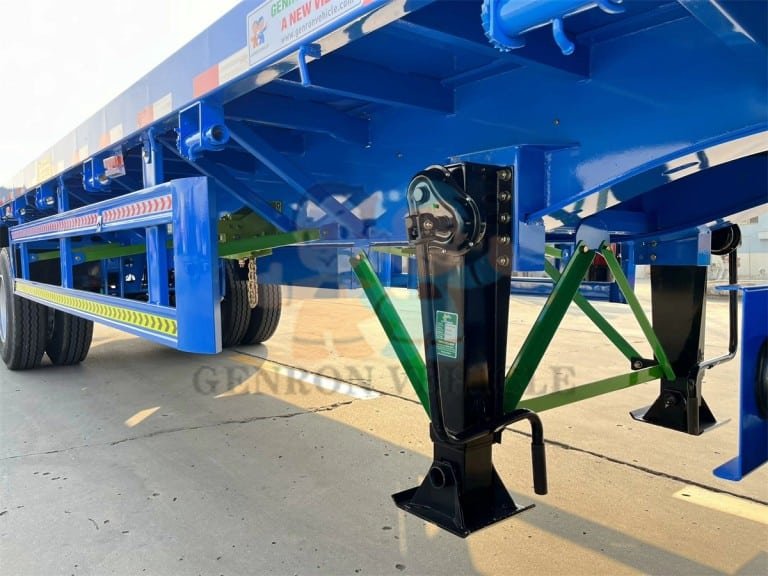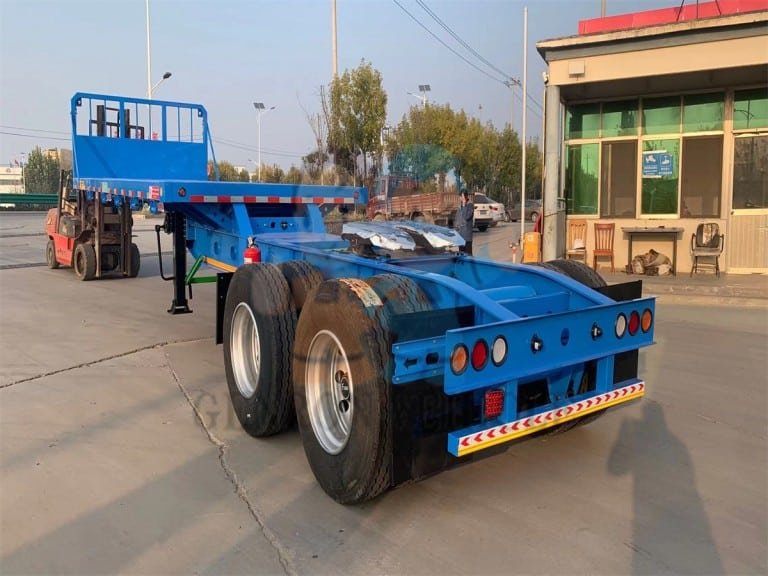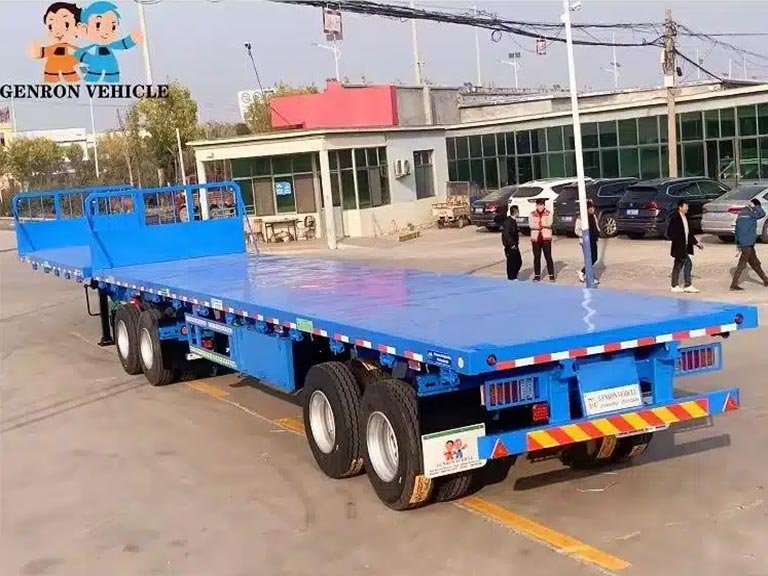Are you aware of the standard width dimensions of flatbed trailers used in the transportation industry? Flatbed trailers are commonly used to transport cargo due to their open design and flexibility. Flatbed trailers have no side walls, making it easy to load and unload large items. This makes them ideal for transporting heavy equipment, construction materials, and bulk cargo.
It is important to understand the width of a flatbed trailer. This is because it affects how efficiently goods can be transported and whether or not they comply with regulations. Different laws may restrict the width of a trailer to ensure safe road travel. Choosing the right width can help maximize load space and reduce transportation costs.
In this article, we will take an in-depth look at “how wide is a semi flatbed trailer”. Providing you with detailed information about flatbed trailer widths and their associated factors.
Table of Contents
Standard Dimensions of Semi Flatbed Trailers
First of all, we should know the standard dimensions of semi-flatbed trailers. This is crucial for efficient towing and transportation operations. Genron International Trade specialize in providing high-quality trailers that meet industry standards.
Industry Standard Width Specifications
The industry-standard width of a semi-flatbed trailer is a critical dimension. This is because it affects its usability and compliance. In the United States, the federal standard maximum width for commercial vehicles, including flatbed trailers, is 102 inches (8.5 feet).
In addition, flatbed trailers range in length from 20 feet to 40 feet. It has a standard wheelbase of 7K, with upgrade options up to 8K wheelbase.
Length and Height Considerations
While width is a crucial factor, the length and height of semi flatbed trailers are also important considerations. Length affects a trailer’s ability to transport large or multiple items. Height, on the other hand, affects its ability to travel in low headroom structures.
Legal Width Regulations Across Different Regions
Legal width regulations vary significantly across different regions. For instance, European regulations typically restrict standard trailer widths to 2.55 meters (approximately 100.4 inches), which is slightly narrower than the U.S. standard.
Many African and South-East Asian countries follow width regulations similar to international standards. However, certain areas may require the use of narrower trailers due to local infrastructure constraints.
Begin with a bespoke semi-trailer designed for your exact needs. Whether it’s heavy-duty hauling or specialized cargo, we’ve got the perfect solution to keep you moving forward.
Types of Semi Flatbed Trailers and Their Width Variations
Semi flatbed trailers are not one-size-fits-all solutions. They are manufactured in various styles to suit different logistical requirements. The type of flatbed trailer used can significantly impact the efficiency and safety of the transport operation.
Standard Flatbed Trailers: Standard flatbed trailers are the most commonly used type for hauling heavy equipment and oversized loads. They offer a straightforward, cost-effective solution for many transportation needs.
Drop Deck (Lowboy) Flatbed Trailers: Drop deck or lowboy flatbed trailers are designed for transporting exceptionally heavy and oversized equipment.
Extendable Flatbed Trailers: Extendable flatbed trailers provide flexibility for loads that require extra length. These trailers can be adjusted to fit a variety of cargo sizes. As such, they are ideal for transporting extra-long or oversized equipment.
Specialized Width Options for Oversized Loads: For really oversized loads, you can choose a specialized flatbed trailer with an expandable width feature. They extend from the standard 102 inches (about 263 cm) to 14 feet (about 4.3 meters) or more. These trailers are equipped with hydraulic or mechanical systems that allow for symmetrical or asymmetrical widening of the flatbed width.

Applications of Semi Flatbed Trailer
Genron International Trade’s flatbed trailers are used in a wide range of applications. Our flatbed trailers are carefully designed to provide the necessary capacity and versatility for a wide range of industries. This includes heavy equipment transportation, construction material transportation, as well as agricultural and industrial uses.
Heavy Equipment Transportation: Semi-flatbed trailers are ideal for heavy equipment transportation. They are typically equipped with air-braked axles, 17.5-inch low-profile radial tires, and Hutchens suspension. Also standard are perforated main frame I-beams, oak flooring, and toolboxes with lockable lids.
Construction Material Hauling: For construction material transportation, semi-flatbed trailers provide the necessary strength and durability. These trailers are able to withstand the rigors of the construction site and ensure that materials are transported safely and efficiently.
Agricultural and Industrial Uses: In addition to heavy equipment and construction material transportation, flatbed trailers are also used for agricultural and industrial purposes. These trailers are designed to handle oversized or heavy loads. They are versatile tools for a variety of industries.
For international shipments, we take into account the regulations of the destination country/region. This is because width standards vary around the world. For example, the European standard is usually 2.55 meters (100.4 inches). while the U.S. standard is 102 inches. In addition, Genron International Trade offers customized flatbed trailer models. This can meet the specific regional requirements of the African and Southeast Asian markets.

Customization Options for Semi Flatbed Trailers
At Genron International Trade, we understand that every transportation need is unique. That’s why we offer a range of customization options for semi-flatbed trailers. Our goal is to provide trailers that meet specific needs, enhancing their functionality and efficiency.
Width Modification Possibilities: We offer width adjustment options for flatbed trailers. This can accommodate oversized loads or specific regional regulations. In addition, our customized flatbed trailers can be designed to meet your specific needs, ensuring safe and efficient transportation.
Regional Adaptations for International Markets: Our semi flatbed trailers can be adapted for international markets, complying with local regulations and standards. We understand the importance of meeting regional requirements, ensuring seamless transportation across borders.
Specialized Features for Specific Industries
In addition, we develop specialized features for various industries, including:
- For the oil and gas industry, we design flatbed trailers with pipe stakes, supports and tie-down systems. They can be used to transport drilling equipment and pipe sections.
- Customized products for agriculture include removable side kits. They can be used to transport bulk materials such as feed, fertilizer or harvested crops.
- Specialized products for the construction industry include reinforced base plates and integrated tool storage boxes. Also included are customized mounting points for securing construction materials and equipment.
- For the renewable energy sector, we offer specialized flatbed designs with extendable frames and fixing systems. This allows them to be used to transport wind turbine components and solar panels.
- Conversion products for the manufacturing sector include customized fixing systems for the loading of finished products, coil wells for the transport of steel and special ramps for the loading and unloading of production equipment.

Conclusion
At Genron International Trade, we understand the importance of flatbed trailers in transportation. Our trailers come in a standard width of 8.5 feet (approximately 2.6 meters), which is compliant with regulations and is suitable for a wide range of roads. Additionally, we offer different types of trailers to meet a variety of cargo needs. This ensures a safe and efficient transportation experience.
When choosing a flatbed trailer, be sure to consider the size and weight of your cargo. In addition, relevant laws and regulations should be observed to ensure smooth transportation. Regular inspection and maintenance of the trailer is also key to getting the most out of it.
If you have questions or need help, feel free to contact us. We will provide you with expert advice to help you choose the right flatbed trailer for your transportation needs.
FAQ
What is the standard width of a flatbed trailer?
The standard width is typically 102 inches, but it can vary depending on the manufacturer and specific model. We offer various width options to suit different hauling needs.
Are there any legal restrictions on the width of a trailer?
Yes, there are regulations governing trailer width, which vary by region and jurisdiction. We ensure our trailers comply with these regulations, and we can advise on specific requirements for your area.
Can I customize the width of my trailer?
Yes, we offer customization options, including width modifications, to suit specific industries or hauling needs. Our team works with you to design a trailer that meets your requirements.
What suspension systems are available for flatbed trailers?
We offer both spring and air ride suspension systems. Air ride suspension provides a smoother ride, while spring suspension is more traditional and cost-effective.
What are the benefits of a gooseneck trailer?
Gooseneck trailers offer improved stability and maneuverability, making them ideal for heavy equipment transportation and other demanding applications.
What axle configurations are available?
We offer various axle configurations to suit different weight distribution requirements, ensuring compliance with regulations and the safe transportation of your cargo.





